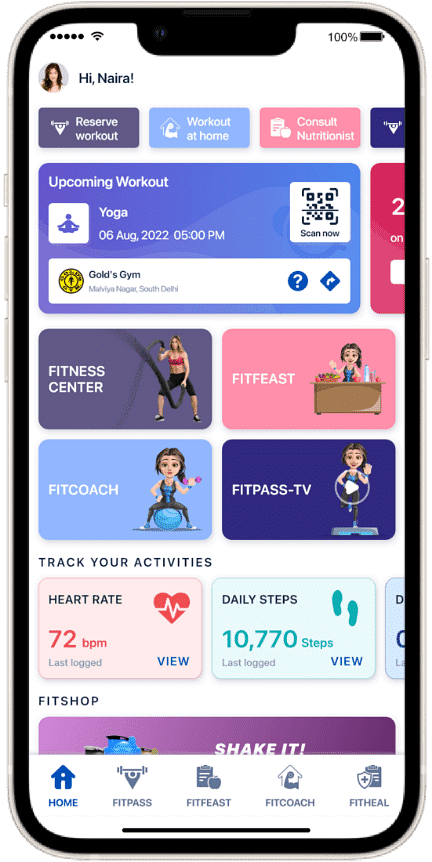Kiss Those Love Handles Goodbye With These 6 Postures Of Power Yoga
If you want a fluid, elastic yet intense workout regime, do Power Yoga. It is a high intensive yoga routine in which there are multiple Vinyasas in a small duration of time. Vinyasa is the coordination of movement and breathing during the transition of one yoga pose to the next. You will sweat, and your heart will have to pump a lot of blood to keep up with you and your flexing muscles.
Power Yoga is derived from the first three parts of the Ashtanga Yoga. The term was coined in the 1990s by Beryl Bender Birch and Bryan Kest, thus, introducing yoga to the U.S and a different version of yoga to the rest of the world.
Moderate fitness is expected of you as it is a combination of fast movements, breathing and, perfecting postures. There are beginners’ level and advanced level in this form of yoga. To attain the yogic flexibility and strength, practice these 6 power yoga postures regularly:
1. Adho Mukha Svanasana (Downward Facing Dog Pose): Funny as its name may sound or interpret to, the Adho Mukha Svanasana is one of the popular poses in the yoga world that provides the perfect stretch.

How to do it:
- Get in the crawl position with your hands and knees on the floor.
- Align your knees to your hips.
- Keep your hands a little forward of the shoulders.
- Spread your palms for proper grip and turn your toes under.
- As you exhale, raise your knees from the floor and straighten your arms along with it forming an inverted V.
Benefits of Adho Mukha Svanasana:
- Adho Mukha Svanasana strengthens the whole body.
- It improves the central and peripheral nervous system.
- It is beneficial for lower back and lung problems, and
- Helps in losing weight.
2. Kumbhakasana (Plank Pose): The word Kumbhakasana is derived from two Sanskrit words, Kumbhak meaning ‘breath retention’ and asana meaning posture. It is one of the important postures for Surya Namaskar or Sun Salutation.

How to do it:
- Begin with Adho Mukha Svanasana and inhale.
- Contract your belly muscles.
- Stretch your torso forward as you support yourself with your arms.
- Look straight down at the floor.
Benefits of Kumbhakasana:
- The Kumbhakasana improves your posture.
- It enhances your endurance.
- The asana tones the abdomen and legs.
- It also strengthens your arms, wrists, and shoulders for more advanced yoga poses.
3. Ustrasana (Camel Pose): Ustrasana or the camel pose is known to be so as the posture looks like a humped camel. This yoga posture opens the Heart Chakra (Anahata) that enhances balance, calmness, and serenity.

How to do it:
- Kneel on the floor.
- Keep your knees hip-width apart.
- Stretch your upper torso and keep your palms on your heels.
- Move your pelvis forward.
- Press your palms firmly on your heels.
Benefits of Ustrasana:
- Ustrasana improves your cardiovascular health.
- It prevents thyroid issues.
- It helps get rid of any digestive problems.
- The yoga posture tones the muscles, and
- Destresses the mind.
4. Salabhasana (Locust Pose): The Salabhasana looks pretty easy but is a challenging pose to perfect in reality.

How to do it?
- Lie on your belly with your arms on your sides.
- Join your big toes.
- Firm your back.
- As you exhale raise your head, the upper torso, arms, and legs.
- Balance your body on your lower ribs, belly and front pelvis.
Why should you do Salabhasana?
- This yoga posture regulates the acid balance in your body.
- Salabhasana improves your metabolism.
- It reduces stress and tension.
- It promotes flexibility and strengthens the spine.
5. Utkatasana (Chair Pose): The Utkatasana is also known as the Fierce Pose and the Powerful Pose. This intense yoga posture is all about sitting on an imaginary chair. An immense amount of tension and resistance are produced during this posture.

How to do it:
- Stand straight, inhale, and raise your arms over your head.
- As you exhale, bend your knees to a squat.
- Squat to the point that your knees extend out over your feet.
- At the same time, keep your thighs parallel to the floor.
Benefits of Utkatasana
- The Utkatasana enhances your coordination and balance.
- Perform this asana to get well-toned legs.
- It promotes core strength.
- It strengthens the back and arms.
6. Balasana (Child Pose): Balasana demonstrates the fetal position of a baby. The main stress in this asana is on the back and thighs. Through this posture, you will find coordination between your body and the gravitational pull.

How to do it:
- Kneel on the floor.
- Join your big toes and sit on your heels.
- Keep your knees hip length apart.
- As you let go of your breath lower your torso between your thighs and extend it forward.
- Try to keep your buttocks on your heels and feel the resistance.
Benefits of Balasana
- Balasana strengthens the hip and back.
- It improves blood circulation in the body.
- The posture toughens the muscles and ligaments of the legs.
- It prevents insomnia and other sleeping disorders.
- It promotes good digestive health.
Whether traditional yoga or power yoga, this fitness regime helps to rejuvenate every part of your body. It is a detailed study of the coordination between the body and the mind that each of us should engage in to know and love ourselves better.
Find the best yoga classes near you with FITPASS – your priority pass to all the gyms and fitness centers. Scroll through numerous fitness centers and choose the one you want to work out at. Sweat it out with the perfect workout. Get.Set.Sweat.


